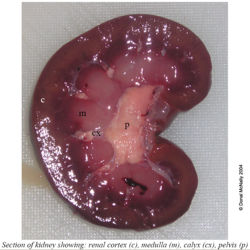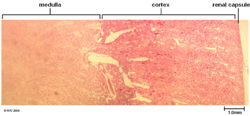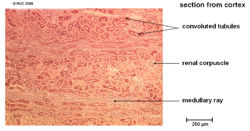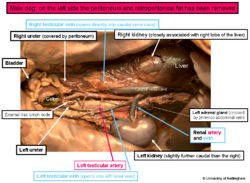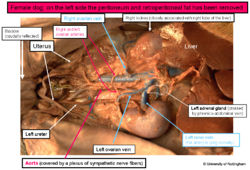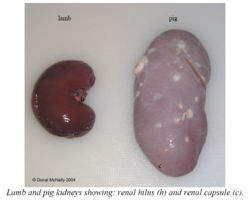Difference between revisions of "Renal Anatomy - Anatomy & Physiology"
Ggaitskell (talk | contribs) |
|||
| (3 intermediate revisions by 3 users not shown) | |||
| Line 108: | Line 108: | ||
===Bovine=== | ===Bovine=== | ||
| − | The kidneys of the bovine do not lose their foetal lobulation. In fact the surface of each kidney is divided into approximately 12 lobules. The right kidney is flattened and ellipsoidal where as the left kidney is thicker at the caudal end than the cranial. Each kidney is surrounded by the capsula adiposa; a layer of fat. Despite what it’s externally lobulated appearance may suggest the cortex of the bovine kidney is continuous and the kidney is of multipyramidal type. The bovine kidney has no renal pelvis but rather the [[Ureters - Anatomy & Physiology | Ureters]] enters the kidney and divide into a cranial and caudal branch. These branches then subdivide and the papilla at the apex of the pyramids open and drain into these. | + | The kidneys of the bovine do not lose their foetal lobulation. In fact the surface of each kidney is divided into approximately 12 lobules. The right kidney is flattened and ellipsoidal where as the left kidney is thicker at the caudal end than the cranial. Each kidney is surrounded by the capsula adiposa; a layer of fat. Despite what it’s externally lobulated appearance may suggest, the cortex of the bovine kidney is continuous and the kidney is of multipyramidal type. The bovine kidney has no renal pelvis but rather the [[Ureters - Anatomy & Physiology | Ureters]] enters the kidney and divide into a cranial and caudal branch. These branches then subdivide and the papilla at the apex of the pyramids open and drain into these. |
The right ureter leaves the kidney and passes along the roof of the abdomen to the pelvis in a fairly standard pattern. The left ureter however moves across the dorsal surface of its kidney to return to the midline and follow a course as if the kidney was located on the left. (both kidneys in the bovine are located on the right see the anatomical landmarks section for further details) | The right ureter leaves the kidney and passes along the roof of the abdomen to the pelvis in a fairly standard pattern. The left ureter however moves across the dorsal surface of its kidney to return to the midline and follow a course as if the kidney was located on the left. (both kidneys in the bovine are located on the right see the anatomical landmarks section for further details) | ||
| Line 114: | Line 114: | ||
===Porcine=== | ===Porcine=== | ||
| − | The kidneys are dorsoventrally flattened. The renal pelvis opens into quite a large space of two major | + | The kidneys are dorsoventrally flattened. The renal pelvis opens into quite a large space of two major calyces from which bud about 10 minor calyces. These attach to one renal papilla each. The kidneys have a smooth surface. |
===Equine=== | ===Equine=== | ||
| Line 193: | Line 193: | ||
}} | }} | ||
| − | + | ==Webinars== | |
| − | + | <rss max="10" highlight="none">https://www.thewebinarvet.com/urogenital-and-reproduction/webinars/feed</rss> | |
[[Category:Kidney - Anatomy & Physiology]][[Category:Bullet Points]] | [[Category:Kidney - Anatomy & Physiology]][[Category:Bullet Points]] | ||
Latest revision as of 19:21, 27 October 2022
Introduction
The kidneys are paired organs which reside in the dorsal abdomen. One on the left and one on the right. Their role is to filter the blood through the glomerulus to form what is known as the filtrate. This filtrate is then on the whole reabsorbed along the nephron until what is left comprises compounds superfluous to the requirements of the organism. Some compounds, normally fully reabsorbed, are on occasion present in the body in excess. The kidney tubules are able to respond to this excess and excrete such compounds in greater amounts. This is how the kidneys play a major role in the homeostasis of the organism. The kidneys also plays a vital role in the total water balance of the organism. Varying their excretion of water in relation to the hydration status of the animal.
The kidneys receive 25% of the cardiac output. From this they filter 20% of the plasma forming a filtrate of which all but 1% is reabsorbed. This equates to all the circulatory volume being filtered and reabsorbed every 30 minutes. The functions of the kidneys are to maintain the volume and composition of plasma, regulate water, ion and pH levels, retain nutrients and excrete waste, toxins and excess electrolytes. The kidneys achieve these functions via; glomerular filtration, solute reabsorption, tubular secretion, water balance and acid-base regulation.
Common Anatomy
- The kidney is the part of the urinary tract where blood is filtered and urine is produced.
- The kidneys are paired and lie in a retroperitoneal position.
- They are positioned in the caudo-dorsal abdomen.
- They lie within a splitting of the sublumbar fascia. This also often contains a large quantity of fat to cushion and protect the kidneys from the pressure of other organs
- The right kidney is most cranial in all species except the pig and grasscutter.
- In species where the right kidney is most cranial it lies in a small fossa of the caudate liver lobe.
- However the left kidney is the most mobile.
- During development all species begin with a multi-lobed structure but a varying degree of fusion occurs between the species giving rise to the various different characteristics seen.
The Basic Components of the Kidney
Outer fibrous capsule
A tough outer capsule surrounds the parenchyma and this prevents the kidney expanding. It is easily stripped away from a healthy kidney but adheres where pathology has occured.
Renal Cortex
- 2 Parts
- External zone
- Internal zone (juxtamedullar)
- Contains the following parts of the nephron
Renal Medulla
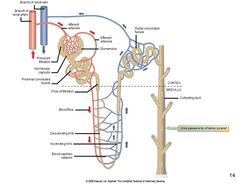
- Contains medullary pyramids
- The part nearest the cortex is the base of the pyramid which narrows to form the inner part - renal papilla
- The medulla can be split into two parts, the outer and the inner
- Different parts of the nephron reside in these areas
Outer Medulla
The outer medulla can be further divided into the outer and inner stripe
The Outer Stripe
This section located just inside the cortex contains the following parts of the nephron:
- Proximal straight tubules
- Distal straight tubules
- Thin descending and thick ascending limbs of the loop of henle
- Outer medullary collecting ducts
- Vasa recta
The Inner Stripe
Located inside of the outer stripe this section contains the following parts:
The Difference
The outer stripe contains the straight proximal tubules and the inner does not. However the inner contains thin ascending limbs and the outer does not. This difference makes up the anatomical demarcation between the two stripes
Inner Medulla
- The inner medulla however only contains the following parts:
Renal Pelvis
- The renal sinus is located within an indentation on the medial side of the kidney
- The renal pelvis is located within the renal sinus
- All papillary ducts open here
- The renal pelvis then drains into the ureters
- The renal pelvis is lined with transitional epithelium
- Varies between species
- Absent in cow
- Contains mucous glands in the horse
Divisions of the Kidney
- The kidney is divided into renal lobes from a structural point of view.
- These can then be divided into a renal pyramid and the piece of cortex above it
- Renal Pyramids are important descriptor of part of the kidney.
- These structures are visible grossly and are the region of the medulla which appears triangular in cross section. They are actually cone shaped and the pointed part which faces towards the renal pelvis is termed the apex and the part against the cortex the base.
- They can also be subdivided into renal lobules comprising of nephrons, a medullary ray and a collecting duct.
- In some species the kidneys are described as multipyramidal this means they have multiple lobes and pyramids. Others are described as unipyramidal meaning they only have one lobe and pyramid.
Innervation
- Sympathetic and parasympathetic fibres from solar plexus
- Travel with renal arteries
- Sympathetic fibres synapse in coeliac ganglion and cranial mesenteric ganglion
Lymphatic Drainage
Renal lymph nodes
Anatomical Species Differences
The various species have major and rather striking differences in the structure of their kidneys.
Canine, Feline, and Ovine
These species all have similar renal anatomy. Their kidneys are relatively short and thick and they are the traditional kidney bean shape. They have a smooth outer surface and have a single renal papilla. The renal pelvis is large and irregular with recesses which are finger like processes.
The kidney of the feline is relatively bigger than the other species and is quite distinctive because the sub-capsular veins which run towards the hilum are visible. The size of the kidney can be estimated by palpation or via imaging. On a ventrodorsal radiograph, normal kidney size is usually between two to three times the length of second lumbar vertebra, 3 - 4.5 centimetres.
Bovine
The kidneys of the bovine do not lose their foetal lobulation. In fact the surface of each kidney is divided into approximately 12 lobules. The right kidney is flattened and ellipsoidal where as the left kidney is thicker at the caudal end than the cranial. Each kidney is surrounded by the capsula adiposa; a layer of fat. Despite what it’s externally lobulated appearance may suggest, the cortex of the bovine kidney is continuous and the kidney is of multipyramidal type. The bovine kidney has no renal pelvis but rather the Ureters enters the kidney and divide into a cranial and caudal branch. These branches then subdivide and the papilla at the apex of the pyramids open and drain into these.
The right ureter leaves the kidney and passes along the roof of the abdomen to the pelvis in a fairly standard pattern. The left ureter however moves across the dorsal surface of its kidney to return to the midline and follow a course as if the kidney was located on the left. (both kidneys in the bovine are located on the right see the anatomical landmarks section for further details)
Porcine
The kidneys are dorsoventrally flattened. The renal pelvis opens into quite a large space of two major calyces from which bud about 10 minor calyces. These attach to one renal papilla each. The kidneys have a smooth surface.
Equine
The equine kidneys not only have very different shapes compared to the rest of the domestic species but they also each have a different shape. The right kidney is described as heart shaped whilst the left is described as being pyramidal. Each organ weighs approximately 700g and both are dorsoventrally flattened. The kidneys are basically unipyramidal and the only demarcation between what were the multiple pyramids of the foetus are the interlobar arteries. This is not always the case in the foal where it is common to be able to identify lobes and the external surface is not always smooth. The horse has a single renal papilla like the dog and its renal pelvis is large and irregular with 2 recesses (finger like processes). The cells of its pelvis secret mucin giving the urine its cloudy appearance.
Anatomical Landmarks
Each species has a slightly different orientation of the kidneys within the abdomen.
Carnivores
The kidneys in these species are very mobile. Especially the left one and especially in the feline. These anatomical landmarks describe the most common locations. The right kidney is more cranial than the left and tends to lie beneath L1 - L3 where as the left tends to lie under L2-L4. The reason the right kidney is less mobile than the left is that it tends to be almost entirely enclosed within the renal fossa of the caudate lobe of the liver. The kidneys are enclosed within a layer of fat and this increases with the obesity of the animal.
Medially to the right kidney you will find the caudal vena cava and the right adrenal gland can be found dorsolateral to this structure but still medially to the kidney. Ventrally can be found the Descending duodenum with the right pancreatic limb more towards the ventromedial aspect. In females the right ovary can be found caudoventrally.
The Cranial pole of the left kidney contacts the greater curvature of stomach it also contacts the spleen on its dorsomedial aspect as well as potentially contacting the left limb of the pancreas. The left adrenal gland can be found at the medial aspect of the cranial pole. The Caudal pole of the left kidney contacts the Small intestine and the Descending colon. At its caudoventral aspect in females is found the left Ovary.
Ruminants
Due to the rumen taking up most of the left side of the abdomen it is normal in the bovine to find both of the kidneys on the right side. In the ovine the kidneys are surrounded by very thick masses of fat which reduce the impact of the rumen on their location. The kidneys in the living animal vary their position substantially with respiration and with the pressure of the other organs.
The right kidney has a retroperitoneal attachment to the "sublumbar" musculature. Cranially it touches the liver. In the dead specimen the right kidney occupies the region between the last rib and somewhere between the 2nd and 3rd lumbar vertebrae’s transverse process. The right kidney usually contacts pancreas, duodenum, adrenal glands and colon as well as the afore mentioned liver.
The left kidney in the bovine is to be found caudoventrally to the right one usually in the region between the 2nd and 4th lumbar vertebrae
Porcine
The left and right kidneys are more or less aligned in the pig unlike other species. The kidneys of the pig are embedded in lots of fat and lie against the psoas muscle. They span the distance between the last rib cranially and the 4th lumber vertebrae caudally. The right kidney does not touch the liver unlike other species and is related ventrally to the descending duodenum and jejunum. The left kidney is ventrally related to the ascending colon, the base of the caecum and the pancreas.
Equine
The kidneys of the horse are both enclosed in a fat capsule. Dorsally they rest against the psoas muscle and against the diaphragm.
The right kidney is to be found ventrally to and between the last 2 ribs and first lumbar transverse process. Cranially it touches the liver and caudally it is attached to the pancreas and the base of caecum. The duodenum winds around its lateral and then ventral surfaces. Medially is the caudal vena cava and adrenal gland.
The left kidney is between the last rib and 3rd transverse process. Its ventral surface is almost completely covered by the peritoneum and contacts the small intestine and and small colon. The spleen contacts it cranioventrally. Medially is the left adrenal gland and aorta.
Renal Blood Supply
- Supplied by renal arteries
- Arise from aorta
- 3-4mm diameter - dog
- Often divide into dorsal and ventral branches before entering kidney
- Common to find double the normal number - dog
Left Renal Vessels
- Left renal artery
- Originates 2cm caudal to the right renal artery
- ~3-4cm long - dog
- Left renal vein
- Immediately ventral to artery
- ~3-4cm long - dog
Right Renal Vessels
- Right Renal Artery
- 2cm cranial to left renal artery
- 4 cm caudal to cranial mesenteric artery
- Passes dorsal over the caudal vena cava
- ~4-5cm long - dog
- Right Renal Vein
- Ventral to artery
- ~4-5cm long - dog
Internal Vascularisation
Once the renal artery enters the kidney is divides into the interlobar arteries. These pass through the gaps between the renal pyramids as the reach the junctions between the cortex and medullar they branch into the arcuate arteries which move over the base of the pyramids. From these come the interlobular arteries which supply the individual lobules of the cortex. These arteries then branch many times to supply individual glomeruli. The capillaries of the glomerulus then rejoin to form one vessel which then forms the peritubular capillaries of that nephron. The interlobular arteries are examples of end arterioles and there are few anastomoses. Obstruction of one of these arterioles causes ischaemic damage in the kidneys. This is also potentially the case with the interlobar arteries.
| Renal Anatomy - Anatomy & Physiology Learning Resources | |
|---|---|
 Test your knowledge using drag and drop boxes |
Comparative Kidney Anatomy Dragster resource |
 Test your knowledge using flashcard type questions |
Macroscopic Renal Anatomy - Renal Flash Cards - Anatomy & Physiology |
 Selection of relevant videos |
Feline Abdomen potcast Bovine pregnant uterus potcast Bovine liver potcast 2 Feline abdominal and pelvic cavity potcast Bovine pregnant uterus potcast 2 Lateral view of the pelvic cavity and reproductive tract of the cow potcast |
Anatomy Museum Resources |
A PowerPoint presentation on the urinary system and comparative kidneys. |
Webinars
Failed to load RSS feed from https://www.thewebinarvet.com/urogenital-and-reproduction/webinars/feed: Error parsing XML for RSS
